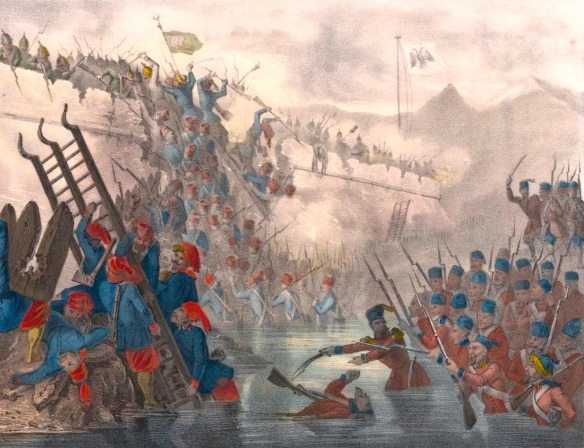
Turkish troops storming Fort Shefketil during the Crimean War of 1853–1856.
The Ottoman army of the Tanzimat period was, against all pessimistic observations and analysis, obviously superior to its predecessors in all aspects (except for the cavalry corps), but it was still in the midst of rapid modernization and reorganization. Some corps and units modernized relatively well, whereas others remained more or less the same. The new military regulations in effect following the famous Tanzimat imperial edict played an important role in improving the conditions of the rank and file, remedying some of the widespread abuses and restructuring the Ottoman military. Starting with the Rýza Pasha Reforms of 1843, the chaotic mass of units organized under five field army commands, excluding the African provinces, were named after areas they were based in—Hassa, Dersaadet (Istanbul), Anadolu (Anatolia), Rumeli (Rumelia), and Arabistan (Arabia but actually Syria only)—and drew soldiers from their respective provinces. The number of field armies was increased to six with the addition of the Army of Baghdad and the Second Army was relocated and renamed as Army of Şumnu in 1848. The others renamed according to the city location of their command posts, but still their old names were used interchangeably with the new ones: Hassa, Manastýr (Bitola)-Rumeli, Erzurum- Anadolu, and Şam (Damascus)-Arabistan.
With the establishment of field armies and changes in the recruitment system, the regular part of the army was renamed the Asakir-i Nizamiye-i Şahane (literally imperial regular soldiers or commonly known as Nizam troops), and the reserve component was renamed as the Asakir-i Redif-i Şahane (imperial reserve soldiers), which retained the moniker Redif. To support the dual Nizam-Redif architecture, a new conscription system was formulated with the enactment of the Kura Nizamnamesi in 1846. According to this new law, the eligible male population of the provinces would assemble in front of an official council, would undergomedical and physical check-ups, and would be divided by lot. The unlucky citizens would be inducted into Nizam units, whereas the lucky ones would be classified as Redif and continue to take part in annual lots until passing the age of 26. The Nizam soldiers were obligated for a five-year duration of active service, to be followed by seven years in the reserve. So, in theory, Redif units consisted of experienced veteran Nizam soldiers and inexperienced and partially trained men.
The field army commanders had both Nizam and Redif units under their commands, thereby abolishing the previous parallel but separate command structure. According to the logic of the new regulations, the Nizam troops could be deployed to any part of the empire depending on the circumstances, whereas the Redifs were allocated for duties in and around their home provinces. However, the Crimean War would show the fallacy of this optimistic thinking, during which the available Redif units of Rumelia were sent to the Caucasus to alleviate the hemorrhage of combat losses.
The magnificent façade of newly constructed barracks barely disguised the infancy of and lack of an effective command and control structure of the field armies. At all of the army headquarters, administrative and logistics elements were missing and existed on paper only. Trained officers remained, especially at the level of senior commanders and staff officers, a rarity, even after the arrival of several hundred Hungarian and Polish refugee officers and later a small number of British military advisors. Not surprisingly, the administration and high command paid limited attention to following a standardized field army structure and both the Danubean and the Caucasian fronts during the Crimean War were organized around specific commanding generals and the geographic alignment of fortresses.
The new regulations of the Tanzimat period clearly improved the conditions of the Ottoman soldiers, but at the same time, like the façades of the new barracks, camouflaged most of the major problems and shortcomings. Many peasant soldiers were absolutely alien to basics of military life like discipline, timetables, and personal hygiene. The administration had difficulty assigning officers to the Nizam units and had almost no trained officers left to man the Redif units. Similarly, the training of Redifs remained anarchic and haphazard in some provinces or, worse, amounted to nothing at all in others. The provincial nature of conscription also affected the combat value of the respective units. Thanks to constant warfare and rebellions, Rumelian and western Anatolian units, which were also lucky to have most of the trained and experienced officers, were battle-hardened. This was not so for the Syrian and Iraqi units in which most of their officers and soldiers had no military experience whatsoever. Moreover, Turkish-speaking officers there had difficulty communicating with their Arabic-speaking soldiers in addition to experiencing cultural problems.
Overall, the Ottoman army had a nominal combat strength of 480,000, including volunteers and units from African provinces of Egypt, Libya (Trablusgarb), and Tunis. The 123,000 Nizamiye (regular) soldiers were well trained, especially the artillery corps, and more or less properly equipped. They were superior to the Russians in several respects; for example, more than 12 elite battalions (Şişhaneci) were armed with Minié rifles (the Russians had none and were unready for their deadly effects). However, the effectiveness of Redif soldiers and the Başibozuks remained problematic, and their combat value was very limited even under ideal conditions. In the confusion of war, the misidentification of these forces was the reason why western military observers encountered difficulty in describing the complicated and often conflicting combat performance of regulars and others in the Army of the Danube and the Army of the Caucasus.